AMD Radeon HD 7870 GHz Edition & Radeon HD 7850 Review: Rounding Out Southern Islands
by Ryan Smith on March 5, 2012 12:01 AM ESTMeet The Radeon HD 7870 & Radeon HD 7850
For today’s review AMD sent over a 7870 and a 7850. Both are built on the 7870 reference design, so the cards are functionally identical except for the configuration of their respective GPU and the number of PCIe power sockets present.
For retail cards this will be very similar to the 7700 series launch, with partners doing semi-custom cards right away. In fact among the list of cards AMD sent us only Club3D will be using the complete 7870 reference design, while everyone else will be using the reference PCB along with their customary open air coolers. The 7850 will be even more divergent since AMD actually has a different, shorter reference PCB for these cards. Consequently our 7850 has very little in common with retail 7850s when it comes to their construction.
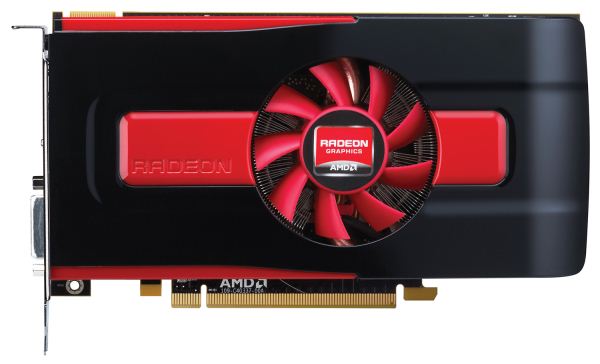
The Radeon HD 7850 Reference Design - Only Sampled To Partners
Starting as always with the cooler, the 7870 reference design is effectively a smaller version of the 7970 reference design. Here AMD is once again using a blower design with a slightly smaller blower, shrouded in the same hard red & black plastic as with the 7900. Underneath the shroud we find AMD’s heatsink, which utilizes a copper baseplate attached to 3 copper heatpipes, which in turn run into an aluminum heatsink that runs roughly half the length of the card. This is fairly typical for a blower design for a sub-200W card, but again almost all of the retail cards will be using a completely different open air design.
The 7870 PCB itself runs 9.5” long, with an additional .25” of shroud overhang bringing the total to 9.75”. Our card is equipped with 8 5GHz 256MB Hynix GDDR5 memory chips, the same 5GHz chips that we saw on the 7700 series. For the 7870 power is provided by a pair of 6pin PCIe power socket, while the sub-150W 7850 uses a single socket. Both cards feature a single CrossFire connector, allowing them to be paired up in a 2-way CrossFire configuration.
Meanwhile for display connectivity AMD is using the same configuration as we’ve seen on the 7900 series: 1 DL-DVI port, 1 HDMI port, and 2 miniDP ports. Interestingly, unlike the 7900 series and 7700 series there is a set of pads for a second DVI port on the card, and while AMD doesn’t make use of them at least one XFX card will. The 7800 series as the same display configuration options as the 7900 series though, so while it can drive up to 6 monitors it can only drive 2 TMDS type displays at once, and if you want to drive a full 6 monitors you’ll need a MST hub.
Finally, I wanted to touch on marketing for a bit. We typically don’t go into any detail on marketing, but with the 7800 something AMD did caught my eye. One of AMD’s marketing angles will be to pitch the 7800 series as an upgrade for the 5800 series; AMD doesn’t typically pitch cards as upgrades in this manner, and the 5800 comparison is especially odd.
At 2.5 years old the 5800 series is no longer the video card king but it’s also not particularly outdated; other than tessellation performance it has held up well relative to newer cards. More specifically, the 7800 series performance is roughly equal to the 6900 series, and while the 6900 series as a step up from the 5800 series it was not a massive leap. With its $350/$250 MSRP the 7800 series has common pricing with the 5800 series, but at only 20-40% faster than the 5800 it’s not the kind of step up in performance that typically justifies such a large purchase. Of course AMD’s conservative pricing has a lot to do with this, but at the end of the day it’s odd to call the 7800 series the upgrade for the 5800 series when the 7950 is the more natural upgrade from a performance perspective.


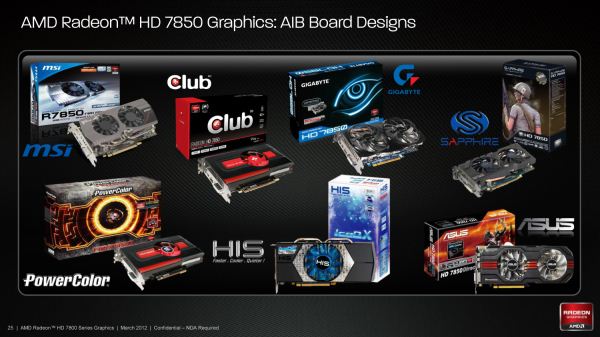
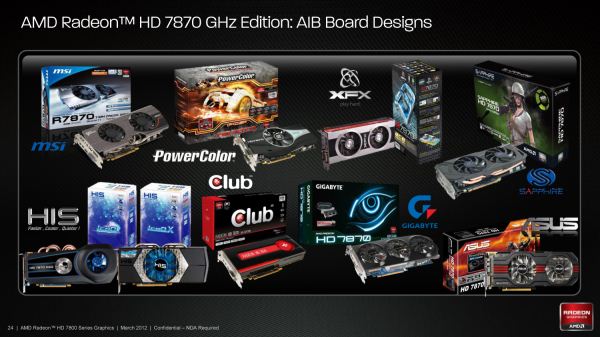

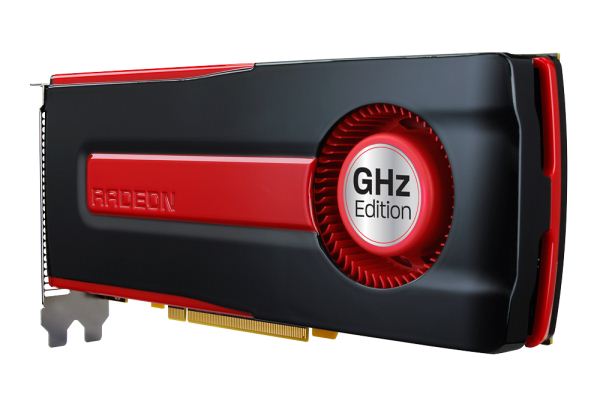












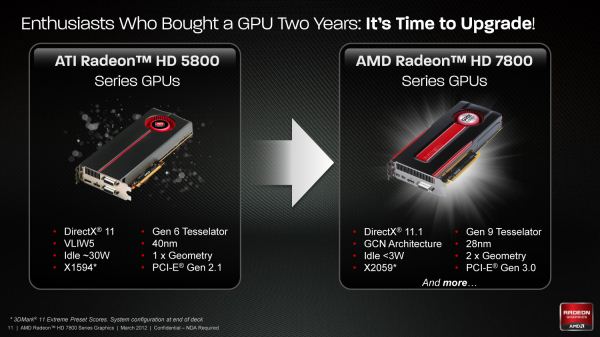








173 Comments
View All Comments
chizow - Monday, March 5, 2012 - link
Sorry, fact checking 101 says the 7850 is still clearly behind the 570, about 10% faster than the GTX 560Ti ($200). The 7870 may be the SKU you're referring to but it costs $350, which again, brings very little movement on pricing:performance relative to 14-16 month old parts.CeriseCogburn - Thursday, March 8, 2012 - link
Hey don't be so factual. medi01 can also look forward to blurred up MLAA, lack of LOD detail compensation, no PhysX, drivers crashing like mad inexplicably for a year or two until things get "ironed out", new games "not running", mouse cursors stuck in corners, whining about tessellation levels in games "it can't handle", and generally blaming nvidia for all it's failures...The "$80" imaginary dollars he saves he can "reinvest" in a "solid" with a "for sure" payoff - his endless hours "fixing" his 7850 "issues".
SlyNine - Monday, March 5, 2012 - link
That's a very 1 dimensional opinion. Compared to the 5870 node change which equaled 2x performance for around the same price, A fab shrink that doesn't double your performance for the money is disappointing.We are comparing it to how past node changes changed the price/performance model. This one is HORRIBLE because it basically slides right in to the old one, so now we have a node change that does very little for price.
I'm running a 5870 which is basically 75% the performance of a 7970, and I paid 379 for the 5870. Which is also 75% of the cost of a 7970. The price of a 7970 is basically the exact same price structure as the 2 1/2 year old 5870, So we are stuck where we were in 2009, yay.
morfinx - Monday, March 5, 2012 - link
75% performance of 7970 would mean that it's 33% faster than a 5870. And that's just not accurate. I have a 5870 as well, so I was paying a lot of attention on how much faster the 7970 is in various reviews. Everything I've read indicates that it's anywhere from 70-110% faster at 2560x1600 resolution (I run 3600x1920, so likely even even more of a difference). That's not even even considering the massive overclocking headroom of the 7970 vs barely any OC headroom of the 5870. Overclocked, a 7970 is easily twice as fast as a 5870.SlyNine - Thursday, March 8, 2012 - link
I should have said 66% for 66% of the price. Point being the price/Performance has not improved...Its around 40-60% faster according to Anandtech's benchmarks.
Overclocked, don't make me laugh.
chizow - Monday, March 5, 2012 - link
@Kiste: Agreed, don't worry about the criticism you're taking. This site has a lot of readers with very low standards or very limited perspective when it comes to the GPU industry.7000 series pricing and performance is a disappointment so far, there's no doubt about it. You can throw as much historical perspective and factual pricing/performance at them but you''ll just be greeted with blank stares and accusations of fanboyism.
Bottomline is this, if Nvidia follows this price and performance structure, EVERYONE would be disappointed.
If Nvidia took 14-16 months and only improved their entire product stack 15-25% on a new architecture and new process node with Kepler while increasing prices accordingly, it'd be a colossal failure.
It makes you wonder why the AMD fans don't see it the same way?
Kaboose - Monday, March 5, 2012 - link
you're acting like Kepler has been released and Nvidia won't be doing the same exact thing, I really doubt we will see Nvidia releasing higher performing cards then AMD at much lower prices like you see to think.chizow - Monday, March 5, 2012 - link
I didn't say we know what Kepler holds, what I'm saying is *IF* Nvidia did this, it would be a colossal failure and we could just write off 28nm entirely. That's why it makes you wonder why AMD fans are giving them a pass for such little improvement in performance and pricing.Honestly, with 15-25% improvement top to bottom over existing SKUs, Nvidia could have simply refreshed their entire Fermi line-up and hit those targets with just clockspeed increases from the smaller process.
At no other point in the history of GPUs has a new process/architecture from either IHV brought so little movement in price and performance. There's no innovation here and no incentive for anyone who bought in the last few generations to bother upgrading.
If you have a 5850/470 or better, there is VERY little reason to upgrade right now especially at the asking prices.
Kaboose - Monday, March 5, 2012 - link
What % of people have 5850/470 or better GPUs though? Im going to say not many. 7850/7870 are good cards for people entering the market on mid range desktops that want to add a GPU for gaming. As well as HTPC use. And for system builders who are looking for a good OC and current gen. technology.Ananke - Monday, March 5, 2012 - link
See Steam statistics. The 5th series was the majority. The largest target market are owners of 5850/5870. I have 5850 and I can afford any card, but I see no reason to upgrade. At this price point gaming is not the only usage, I want quality hardware video encoding acceleration by MANY software packages, GPGPU applications. Today, in those areas, AMD has actually even less applications than when they launched the 5th series.For SO much money and NO applications outside gaming the ONLY reason not to use NVidia would be heat dissipation. If Kepler cards are colder, NVidia has a win.